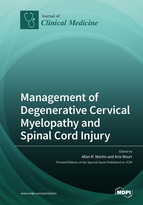Management of Degenerative Cervical Myelopathy and Spinal Cord Injury
A special issue of Journal of Clinical Medicine (ISSN 2077-0383). This special issue belongs to the section "Clinical Neurology".
Deadline for manuscript submissions: closed (15 January 2022) | Viewed by 57054
Special Issue Editors
2. Department of Surgery and Spine Program, University of Toronto, Toronto, ON M5T 1P5, Canada
Interests: scoliosis; kyphosis; spondylolisthesis; trauma; tumors; cervical myelopathy; lumbar stenosis; disc herniations; rheumatoid arthritis; infections; connective tissue disorders; syringomyelia; Chiari malformations
Interests: Degenerative Cervical Myelopathy (DCM); Magnetic Resonance Imaging (MRI); cervical canal stenosis; Subacute Combined Degeneration of the Spinal Cord (SACD); anemia and DCM; cervical spine surgery; surgical decision-making; surgical outcome prediction; Ossification of the Posterior Longitudinal Ligament (OPLL); cervical spondylolithesis
Special Issues, Collections and Topics in MDPI journals
Special Issue Information
Dear Colleagues,
Degenerative cervical myelopathy (DCM) and traumatic spinal cord injury (SCI) represent two of the most important conditions affecting the spinal cord, affecting millions of individuals worldwide and causing substantial disability. DCM and SCI are unique pathologies with marked differences in etiology and demographics, but they show many similarities in terms of anatomical features, pathophysiological mechanisms, and therapeutic challenges, offering several benefits to studying these conditions in parallel. Clinical management of these conditions has evolved substantially over several decades, including clinical assessments, imaging, electrophysiology studies, non-operative therapies, operative techniques, and rehabilitation strategies. Clinical decision-making is increasingly informed by clinical practice guidelines sponsored by neurosurgical and spine organizations, but these guidelines are a work in progress and leave many areas of uncertainty for clinicians. In the near future, we can expect the management of DCM and SCI to change dramatically as high-quality evidence and novel imaging tools, surgical technologies, and biological therapies become available. This issue of the Journal of Clinical Medicine offers a snapshot of current evidence and state-of-the-art clinical practice, and a forecast of what the future may look like for the management of DCM and SCI.
Dr. Allan R. Martin
Dr. Aria Nouri
Guest Editor
Manuscript Submission Information
Manuscripts should be submitted online at www.mdpi.com by registering and logging in to this website. Once you are registered, click here to go to the submission form. Manuscripts can be submitted until the deadline. All submissions that pass pre-check are peer-reviewed. Accepted papers will be published continuously in the journal (as soon as accepted) and will be listed together on the special issue website. Research articles, review articles as well as short communications are invited. For planned papers, a title and short abstract (about 100 words) can be sent to the Editorial Office for announcement on this website.
Submitted manuscripts should not have been published previously, nor be under consideration for publication elsewhere (except conference proceedings papers). All manuscripts are thoroughly refereed through a single-blind peer-review process. A guide for authors and other relevant information for submission of manuscripts is available on the Instructions for Authors page. Journal of Clinical Medicine is an international peer-reviewed open access semimonthly journal published by MDPI.
Please visit the Instructions for Authors page before submitting a manuscript. The Article Processing Charge (APC) for publication in this open access journal is 2600 CHF (Swiss Francs). Submitted papers should be well formatted and use good English. Authors may use MDPI's English editing service prior to publication or during author revisions.
Keywords
- Degenerative cervical myelopathy (DCM)
- Traumatic spinal cord injury (SCI)
- Clinical assessments
- Imaging
- Electrophysiology
- Non-operative therapies
- Operative techniques
- Rehabilitation strategies








